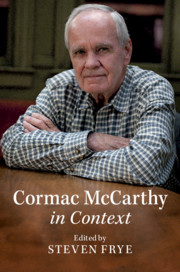Book contents
- Cormac McCarthy in Context
- Cormac McCarthy in Context
- Copyright page
- Contents
- Contributors
- Acknowledgments
- Chronology
- Part I Environments
- Part II Literary Contexts: Sources, Influences, Allusions
- Chapter 5 William Faulkner
- Chapter 6 Ernest Hemingway
- Chapter 7 Herman Melville and the American Romance Tradition
- Chapter 8 Romanticism
- Chapter 9 Naturalism
- Chapter 10 The Bible
- Chapter 11 Allusion and Allegory
- Part III Intellectual Contexts
- Part IV Social and Cultural Contexts
- Part V Archives, Critical History, Translation
- Works Cited
- Index
Chapter 5 - William Faulkner
from Part II - Literary Contexts: Sources, Influences, Allusions
Published online by Cambridge University Press: 12 December 2019
- Cormac McCarthy in Context
- Cormac McCarthy in Context
- Copyright page
- Contents
- Contributors
- Acknowledgments
- Chronology
- Part I Environments
- Part II Literary Contexts: Sources, Influences, Allusions
- Chapter 5 William Faulkner
- Chapter 6 Ernest Hemingway
- Chapter 7 Herman Melville and the American Romance Tradition
- Chapter 8 Romanticism
- Chapter 9 Naturalism
- Chapter 10 The Bible
- Chapter 11 Allusion and Allegory
- Part III Intellectual Contexts
- Part IV Social and Cultural Contexts
- Part V Archives, Critical History, Translation
- Works Cited
- Index
Summary
From the first reviews of The Orchard Keeper, Cormac McCarthy’s debut novel – published just three years after William Faulkner’s death and edited by Albert Erskine, who had worked with the Nobel laureate at Random House – comparisons with Faulkner’s work have been irresistible in the discussion of McCarthy’s fiction. This chapter focuses on key moments in McCarthy’s oeuvre that suggestively cite, parody, contest, unwrite, or otherwise engage Faulkner’s writings, to mine these connections for deeper insights into theme, form, and vision in two of the most distinguished bodies of work in American fiction. Most explicit in Suttree, with its overt echoes and revisions of The Sound and the Fury, McCarthy’s running intertextual dialogue with Faulkner also surfaces to notable effect in All the Pretty Horses, Blood Meridian, The Crossing, The Road, and the many places in McCarthy’s work where the county figures as a meaningful imaginative geography, political formation, or social unit – thereby conjuring the specter of Faulkner’s fictional Mississippi county of Yoknapatawpha, perhaps his supreme imaginative achievement. Other Faulkner works discussed include Absalom, Absalom!, Go Down, Moses, and A Fable.
- Type
- Chapter
- Information
- Cormac McCarthy in Context , pp. 47 - 58Publisher: Cambridge University PressPrint publication year: 2020

